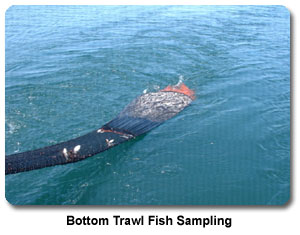- Home
- About S&T
- Taxa/Organisms
- Ecosystems
- Issues
- Methods & Tools
- Reports & Publications
- Location
- Search
2002 | Publisher: USGS | Science Center: Western Fisheries Research Center (WFRC, Seattle) | Format: URL
wfrc.usgs.gov — The value of this long-term monitoring program will provide data crucial for understanding demographic and reproductive characteristics of these endangered sucker populations. This research will have wide applicability to federal, state, and tribal agencies in the basin for management and recovery efforts.

Publisher: USGS | Science Center: Western Fisheries Research Center (WFRC, Seattle) | Format: URL
wfrc.usgs.gov — An entrainment study at Grand Coulee Dam indicated that 200,000 - 600,000 kokanee were entrained, primarily at the 3rd powerhouse, during a 40-month time period. Following the recommendations of the Independent Scientific Review Panel, research was initiated to investigate a strategy to reduce entrainment by using strobe lights to repel salmonids More...

Publisher: USGS | Science Center: Western Fisheries Research Center (WFRC, Seattle) | Format: URL
wfrc.usgs.gov — Mercury contamination from historic gold mining operations is widespread in many rivers, lakes, and reservoirs on the western slopes of the Sierra Nevada. A multidisciplinary investigation by USGS is attempting to better understand mercury dynamics and to identify hot spots within Camp Far West Reservoir in order to determine if remediation More...

Publisher: USGS | Science Center: Western Fisheries Research Center (WFRC, Seattle) | Format: URL
wfrc.usgs.gov — The objectives of this study are 1) to determine how and when juvenile suckers use near-shore habitat with emergent vegetation, 2) determine how the distribution and abundance of juvenile suckers varies between near shore and offshore areas as well as between different areas of the lake over time, 3) determine if water quality conditions affect More...

Publisher: USGS | Science Center: Western Fisheries Research Center (WFRC, Seattle) | Format: URL
wfrc.usgs.gov — Artificially maintained water levels within the lake and stresses placed upon the aquifer by well withdrawals facilitate movement of water from the lake into the local ground water system, potentially allowing contaminants to enter the aquifer from the lake. This raises national concern because similar lakeside settings exist throughout the United More...

Publisher: USGS | Science Center: Alaska Science Center (ASC, Anchorage) | Format: URL
www.absc.usgs.gov — Ecological Genetics of the Lake Clark Sockeye Salmon (Oncorhynchus nerka) characterizes the population structure and genetic diversity. This issue overview aids managers in defining and prioritizing conservation units of sockeye salmon within Lake Clark National Park and Preserve.

Publisher: USGS | Science Center: Western Fisheries Research Center (WFRC, Seattle) | Format: URL
wfrc.usgs.gov — Lake Natoma, an 8,760 acre-feet reservoir on the American River, is managed by the U.S. Bureau of Reclamation (USBR) for multiple uses that include fishing and other water-based recreation. Preliminary results from 22 fish samples collected in Lake Natoma during August 2000 indicate that the mercury content may approach or exceed guidelines for More...

Publisher: USGS | Science Center: Western Fisheries Research Center (WFRC, Seattle) | Format: URL
wfrc.usgs.gov — Bacterial kidney disease (BKD) caused by Renibacterium salmoninarum has been implicated as a significant factor in the 5-year decline of the chinook salmon populations in Lake Michigan that began during 1988. In 1999, researchers at the WFRC began a multi-year study in coordination with Great Lakes fishery biologists to examine the role of BKD in More...

Publisher: USGS | Science Center: Great Lakes Science Center (GLSC, Ann Arbor) | Format: URL
www.glsc.usgs.gov — The USGS Great Lakes Science Center (GLSC) has a long history of significant contributions to the understanding of aquatic resources in the Great The main focus of the Center's research is on the long-term dynamics of native and non-native aquatic species and the sustainability of Great Lakes fisheries. Since the Center was established, the fish More...

Publisher: USGS | Science Center: Western Fisheries Research Center (WFRC, Seattle) | Format: URL
wfrc.usgs.gov — This issue overview addresses the concerns of aquatic community dynamics in Bonneville Reservoir, Columbia River and Tributary Streams, which have been affected by a combination of hydropower development, species introductions and invasions, over-harvest, and habitat degradation in tributaries from agricultural practices. The nature of these More...

Publisher: USGS | Science Center: Western Fisheries Research Center (WFRC, Seattle) | Format: URL
wfrc.usgs.gov — Severe water quality problems in Upper Klamath Lake, OR have led to concerns about how Lost River and shortnose suckers are distributed during the summer and whether suckers utilize areas of water quality refuge. In 2002, the USGS initiated a joint study between the Klamath Falls Field Station and the Oregon District, Water Resources Office to More...

Publisher: USGS | Science Center: Western Fisheries Research Center (WFRC, Seattle) | Format: URL
wfrc.usgs.gov — As anadromous juvenile salmonids migrate from freshwater rearing habitats to the ocean, they are vulnerable to a host of factors that affect their survival. Direct effects associated with dam passage (e.g., instantaneous mortality, injury, loss of equilibrium, etc.) and indirect effects (e.g., predation, disease, and physiological stress) More...
